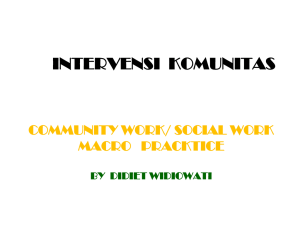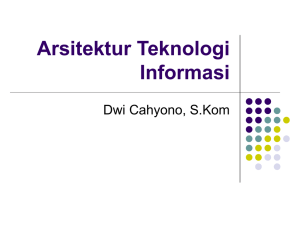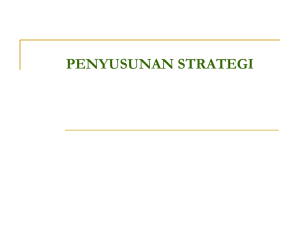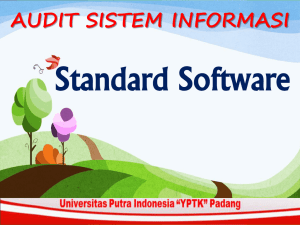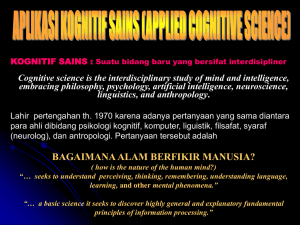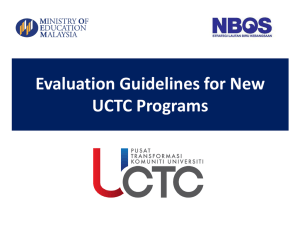minggu5 analisis postur kerja
advertisement
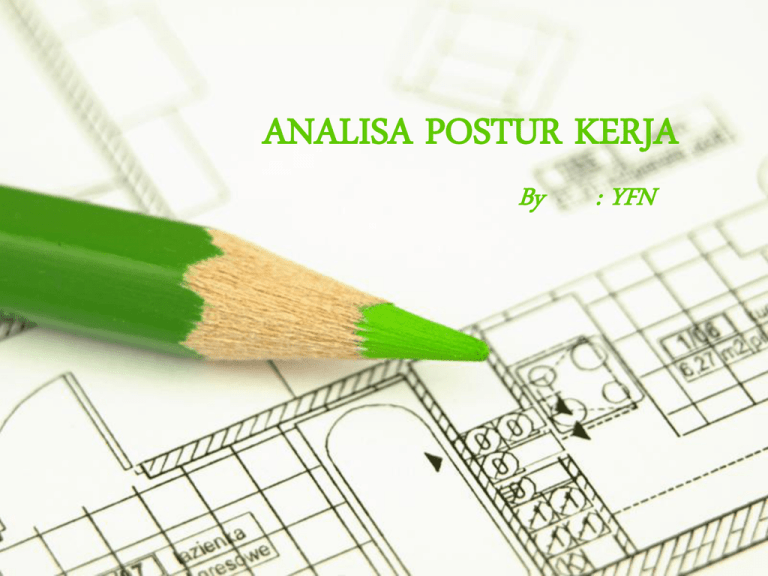
ANALISA POSTUR KERJA By : YFN Page 1 OVERVIEW • Pengertian Postur Kerja • Rancangan yang sesuai dengan Postur Operator • Penyebab Cumulative Trauma Disorders • Metode Untuk Menganalisis Postur Kerja • RULA, REBA, ROSA Page 2 POSTUR KERJA • • • • • • Postur kerja yang baik sangat ditentukan oleh pergerakan organ tubuh saat bekerja. Pergerakan yang dilakukan saat bekerja meliputi : Flexion ( gerakan dimana sudut antara dua tulang terjadi pengurangan ) Extension ( gerakan merentangkan (stretching) dimana terjadi peningkatan sudut antara dua tulang ) Abduction ( pergerakan menyamping menjauhi dari sumbu tengah (the median plane) tubuh ) Adduction ( pergerakan kearah sumbu tengah tubuh (the median plane) ) Pronation ( perputaran bagian tengah (menuju kedalam) dari anggota tubuh ) Supination ( perputaran kearah samping (menuju keluar) dari anggota tubuh ) Page 3 Rancangan untuk Operator yang Berdiri Posisi kerja berdiri memang kurang nyaman, namun dengan posisi berdiri, operator menjadi lebih leluasa dan dapat menjangkau area yang lebih luas. Posisi tersebut hanya bisa dilakukan dalam waktu singkat karena dengan posisi berdiri akan mengakibatkan resiko fatigue pada operator lebih besar, sehingga perancangan yang tepat dan nyaman untuk operator yang berdiri sangatlah penting. Page 4 Contoh Work Space yang didesain untuk operato berdiri: Halaman 363 gbr 8.5 • Tinggi workstation disesuaikan dengan jangkauan tangan, tinggi siku dan ukuran dari objeknya • Objek terberat diletakkan antara elbow dan hip height • Alat bantu kerja disesuaikan dengan jangkauan tangan dan objek pekerjaan • Pada lantai workplace harus tidak ada halangan dan lurus agar kakik bisa bergerak dengan mudah Page 5 Namun kebanyakan operator mengeluhkan bekerja sambil berdiri, padahal pekerjaan dengan berdiri kadang kala harus dilakukan, sehingga diciptakanlah stand-seat. Sehingga operator dapat menyelsaikan pekerjaan yang mengharuskan posisi berdiri dalam keadaan duduk. Halaman 364 gbr 8.6 Page 6 Rancangan untuk Operator yang Duduk Posisi operator saat duduk lbih nyaman dibandingkan operator berdiri. Namun pada posisi duduk jangkauan tangan operator akan semakin sempit. Jika berbicara mengenai rancangan workplace untuk operator duduk, ada beberapa hal yang harus dipehatikan : • Tersedia ruang atau space yang cukup untuk kaki operator • Untuk tinggi tempat kerja, memperhatikan tinggi siku duduk Halaman 366 gbr 8.8 • Kursi yang digunakan menggunakan tinggi yang sesuai dengan tinggi popliteal dimana sekitar 35 sampai 50 cm Page 7 Rancangan untuk Operasi Alat dengan Kaki Jika dibandingkan dengan pergerakan tangan, pergerakan kaki lebih banyak membutuhkan energi, serta keakuratan kurang dan lebih lambat. Namun, dengan menggunakan kaki lebih kuat. (Astrand and Rodahl, 1986; Hoffman, 1991) Salah satu contoh pekerjaan yang menggunakan kaki adalah mengayuh sepeda, Dimana energi atau tekanan diberikan oleh kaki terhadap pedalnya. Oleh karena itu, posisi kaki dan tubuh yang nyaman akan sangat membantu memaksimalkan energi dan tekanan yang dikeluarkan kaki dalam mengayuh sepeda. Page 8 Berikut merupakan gambar yang menunjukan hubungan antara maksimum Force dari kaki dengan posisi dan sudut tertentu : Halaman 378 gbr 8.18 Halaman 379-380 gbr 8.198.21 Page 9 Rancangan untuk Operasi Alat dengan Tangan (Hand Tool) Dalam mendesain Hand tool ada beberapa hal yang harus diperhatikan, yaitu kontur dari tangan yang sesuai, dan juga harus memperhatikan ruang gerak tangan agar memaksimalkan energi yang dikeluarkan operator. Selain itu mendesain Hand tool kita juga perlu mengetahui tentang jenis-jenis coupling dan kekuatan maksimal yang dapat dilakukan oleh tangan, agar kita dapat memanfaatkan penggunaan tangan dengan maksimal dan menimimalisir adanya resiko cidera. Page 10 Berikut merupakan jenis-jenis coupling : Halaman 386 gbr 8.26 Page 11 Tabel dibawah merupakan energi yang dikeluarkan tangan pada gerakan tertentu yang diadaptasi dalam MIL-HDBK759 : Halaman 388 gbr 8.28 Page 12 CUMULATIVE TRAUMA DISORDER Cumulative Trauma Disorders (dapat disebut sebagai Repetitive Motion Injuries atau Musculoskeletal Disorders) adalah cidera pada sistem kerangka otot yang semakin bertambah secara bertahap sebagai akibat dari trauma kecil yang terus menerus yang disebabkan oleh desain buruk yaitu desain alat/sistem kerja yang membutuhkan gerakan tubuh dalam posisi yang tidak normal serta penggunaan perkakas/handtools atau alat lain yang terlalu sering (Tayyari & Smith, 1997) Page 13 CUMULATIVE TRAUMA DISORDER Faktor penyebab timbulnya CTD : • Penggunaan gaya yang berlebihan selama gerakan normal • Gerakan sendi yang kaku yaitu tidak berada pada posisi normal. Misalnya, bahu yang terlalu terangkat, lutut yang terlalu naik, punggung terlalu membungkuk, dan lain – lain • Perulangan gerakan yang sama secara terus – menerus • Kurangnya istirahat yang cukup untuk memulihkan trauma sendi Page 14 Shoulder injury, Neck injury, Page 15 METODE UNTUK MENGANALISIS POSTUR KERJA RULA REBA ROSA Analisis postur kerja untuk meminimalisasi terjadinya cidera pada punggung (LBP) telah dilakukan dengan berbagai metode, seperti RULA, REBA, NIOSH, OWAS, dan lainnya. Metode tersebut bertujuan untuk mengidentifikasi postur kerja, menentukan apakah postur yang dilakukan sudah aman dan nyaman serta memberikan rekomendasi perbaikan postur kerja. Rekomendasi ditunjukkan dengan menentukan klasifikasi postur, sudah termasuk aman atau belum kemudian tindakan apa yang perlu dilakukan. Page 16 RULA Rapid Upper Limb Assesment adalah metode yang menginvestigasi dan menilai posisi kerja yang dilakukan oleh tubuh bagian atas. Peralatan ini tidak memerlukan piranti khusus dalam memberikan suatu pengukuran postur leher, punggung, dan tubuh bagian atas, sejalan dengan fungsi otot dan beban eksternal yang ditopang oleh tubuh. (McAtamney, 1993) Page 17 Penilaian menggunakan RULA merupakan metode yang telah dilakukan oleh McAtemney dan Corlett (1993).Tahaptahap menggunakan metode RULA adalah sebagai berikut : 1.Pengembangan metode untuk pencatatan postur bekerja 2. Perkembangan sistem untuk pengelompokan skor postur bagian tubuh • Tubuh dibagi menjadi dua bagian yaitu grup A (lengan atas, lengan bawah, pergelangan tangan) dan grup B (leher, badan,kaki). Dan kemudian diberi score untuk setiap grup. • Dari tiap grup tersebut kemudian dimasukan dalam tabel dan selanjutnya akan diperoleh Grad Skor dengan cara seperti pada gambar. Page 18 tabel grand skor 3.Pengembangan • Pembuatan dengan mengkombinasikan Grand Skor dan skor C dan D diberi rating Daftar Tindakan yang bernilai 1 sampai 7 Setelah diperoleh grand skor, yang bernilai 1 hingga 7 menunjukkan level tindakan (action level) sebagai berikut : • Action level 1 Suatu skor 1 atau 2 menunjukkan bahwa postur ini bias diterima jika tidak dipertahankan atau tidak berulang dalam periode yang lama. • Action level 2 Skor 3 atau 4 yang menunjukkan bahwa diperlukan pemeriksaan lanjutan dan juga diperlukan perubahan-perubahan. • Action level 3 Skor 5 atau 6 menunjukkan bahwa pemeriksaan dan perubahan perlu segera dilakukan • Action level 4 Skor 7 menunjukkan bahwa kondisi ini berbahaya maka pemeriksaan dan perubahan diperlukan dengan segera (saat itu juga) Page 19 Tabel RULA Page 20 REBA Rapid Entire Body Assessment adalah sebuah metode yang digunakan secara cepat untuk menilai posisi kerja atau postur leher, punggung, lengan, pergelangan tangan, dan kaki seorang operator. Selain itu metode ini juga dipengaruhi oleh faktor coupling, beban eksternal yang ditopang oleh tubuh serta aktivitas pekerja. (Hignett & McAtamney, 2000) Page 21 Berikut merupakan tahapan-tahapan penilaian menggunakan metode REBA yang telah dilakukan oleh Dr. Sue Hignett dan Dr. Lynn McAtamney : 1. Pengambilan data postur pekerja dengan menggunakan bantuan video atau foto Bertujuan Untuk mendapatkan gambaran sikap (postur) pekerja dan leher, punggung, lengan, pergelangan tangan hingga kaki secara terperinci dilakukan dengan merekam atau memotret postur tubuh pekerja 2. Penentuan sudut – sudut dari bagian tubuh pekerja Segmen tubuh dibagi menjadi dua grup. Grup A (punggung, leher, kaki) dan grup B (lengan atas, lengan bawah, pergelangan tangan). Untuk kemudian diberi score pada tabel grup masing-masing Page 22 3. Penentuan berat benda yang diangkat, coupling, dan aktifitas pekerja Selain scoring pada masing-masing segmen tubuh, faktor berat beban juga diberi score sesuai tabel masing-masing faktor 4. Perhitungan nilai REBA untuk postur yang bersangkutan Setelah didapatkan skor dari tabel A kemudian dijumlahkan dengan skor untuk berat beban yang diangkat sehingga didapatkan nilai bagian A. Dan dari tabel B dijumlahkan dengan skor dari tabel coupling sehingga didapatkan nilai bagian B. Dari nilai A dan B diperoleh nilai C pada tabel. Sehingga, Nilai REBA didapatkan dari hasil penjumlahan nilai bagian C dengan nilai aktivitas pekerja. Dandiketahui level resiko pada musculoskeletal dan tindakan yang perlu dilakukan untuk mengurangi resiko serta perbaikan kerja Page 23 TABEL LEVEL RESIKO DAN TINDAKAN Page 24 Tabel REBA Page 25 ROSA ROSA is a picture based posture checklist designed to quantify exposure to risk factors in an office work environment. ROSA is modelled after other picture based checklists and chart scoring systems such as RULA and REBA. The goal of the ROSA process is to serve as a screening tool to identify areas of priority in large office based organizations. The Result Research has shown a correlation between discomfort levels and increasing ROSA scores. The Scores of greater than 5 are deemed to be “high risk” and the workstation should be assessed further. Page 26 Tabel ROSA Page 27 seat pan height /depth Tahapan Penilaian dalam Metode ROSA 2 3 4 5 6 7 8 2 1 2 3 4 5 6 7 3 2 2 3 5 5 6 7 Arms / Back rest 4 5 6 3 4 5 3 4 5 3 4 5 4 4 5 5 5 5 6 7 7 7 8 8 7 6 6 7 7 8 8 9 8 7 7 7 7 8 9 9 9 8 8 8 8 9 9 9 Section A – The Chair Chair Height and Pan Depth Select the position of the seat height and chair pan. The first position in the left column indicates the neutral position. This corresponds with a score of “1”. The remaining positions are marked with increasing scores. Those sections with scores such as (+1) (ie., Insufficient Space Under Desk) are additive scores. These can be added on to the other scores. For Example, if the chair height is too high (2), and it is non-adjustable (+1), this becomes a score of 3. The score from the Chair Height is then added to the Pan Depth to receive the final score from this section. This score will correspond with the vertical axis along the Section A scoring chart. Page 28 Contoh Penilaian Sebuah Kursi dengan Metode ROSA Risk Factor Example Too low The height adjustment cylinder is set to its lowest height, and the worker is tall. Too high The knee angle is greater than 90 degrees, and there is pressure under the thigh. Too high – no foot contact The worker is using a stool or lab height chair, so the feet cannot physically touch the floor. Insufficient space under The desk Picture The keyboard tray or a computer tower blocks the legs from moving freely under the desk Page 29 Risk Factor Example Seat pan depth – too long There is less than 2-3” of space behind the knee when the person sits back in the chair. Seat pan depth – too short There is more than 2-3” of space behind the knee when the person sits back in the chair. This may focus pressure on the underside of the thigh, and the thigh will not be supported. Picture Page 30 seat pan height /depth 2 3 4 5 6 7 8 2 1 2 3 4 5 6 7 3 2 2 3 5 5 6 7 Arms / Back rest 4 5 6 3 4 5 3 4 5 3 4 5 4 4 5 5 5 5 6 7 7 7 8 8 7 6 6 7 7 8 8 9 8 7 7 7 7 8 9 9 Section A – The Chair, Continued Arm Rests, Back Support and Duration of Sitting Select the position of the arm rests. Once again, the scores that can be added on to postures are indicated by a (+) in front of the number. The scores from both the arm rest section and the backrest section combined will amount to the score across the top axis on the scoring chart. Page 31 9 8 8 8 8 9 9 9 Seat Pan Height /Depth Arms / Back rest 2 3 2 1 2 3 2 4 5 6 7 8 9 3 4 5 6 7 8 2 3 4 5 6 7 8 3 3 3 4 5 7 7 8 5 4 4 4 4 5 7 7 8 6 5 5 5 5 5 8 8 9 7 6 6 6 7 7 8 9 9 8 7 7 7 8 8 9 9 9 1 4 5 The combined score from the arm and back rest section will then be compared on the horizontal axis againstthe seat pan depth and height on the vertical axis. The square in which the scores land will then be the score for the chair. To account for the duration that the worker spends in the chair per day, a score of -1 will be assigned if the worker spends less than 1 hour a day in the chair throughout the day, or for less than 30 minutes consecutively. If the worker spends 1-4 hours a day intermittently, or between 30 minutes to 1 hour continuously in the chair, the duration score is 0. If the worker spends more than 4 hours a day in the chair intermittently, or greater than 1 hour consecutively, the duration score will be +1. Add the duration score to the chair score to receive your final chair score. This will represent your score for section A, which will be used later to achieve a final score for the office. Page 32 Phone 0 1 2 3 4 5 6 0 1 1 1 2 3 4 5 1 1 1 2 2 3 4 5 2 1 2 2 3 4 5 6 Monitor 3 4 2 3 2 3 3 3 3 4 4 5 5 6 7 8 5 4 4 4 5 6 7 8 6 5 5 6 6 7 8 9 Section B – Telephone and Monitor Select the scores as present related to the monitor position for the worker. With this score, add 1 for use of the monitor of greater than 4 hours per day intermittently, or 1 hour consecutively. Add a duration score of 0. if the work is between 1-4 hours intermittently, or 30minutes to 1 hour consecutively. Subtract 1 if there is less than 1 hour of work done per day intermittently, or less than 30 minutes consecutively. This score is then to be used long the horizontal axis Select a score related to the position and usage of the telephone. Add in a duration factor of +1, 0 or -1 based on the amount of time the worker spends on the phone per day. This score is then to be used along the vertical axis. Compare the score between the horizontal and vertical axis as done with the chair score. This score becomes the Section B ROSA score, which will be used again later to receive the grand score. Page 33 7 6 6 7 8 8 9 9 Scoring examples - Monitor Risk Factor Example Monitor too low The top of the screen is 30 degrees below the sitting eye height causing neck flexion Monitor too high The top of the screen is above eye level, causing the neck to be extended while viewing the screen. Neck twist. The monitor is positioned to the side of the worker, or dual screens may cause the worker to rotate the head back and forth Documents used – no twist the neck Picture The worker has to flex and document holder in order toview papers positioned onthe desk Page 34 Scoring Examples - Telephone Risk factor Too far – reach. Example Picture The phone is positioned at the back of the desk, and when it rings, the worker has to extend and bend over the surface to grab the handset Neck and Shoulder hold The worker has to use the phone and computer at the same time, and in order to type, they will pinch the handset between the neck and the shoulder. Page 35 Mouse 0 1 2 3 4 5 6 7 0 1 1 1 2 3 4 5 6 1 1 1 2 3 4 5 6 7 2 1 2 2 3 4 5 6 7 3 2 3 3 3 5 6 7 8 Keyboard 4 5 3 4 4 5 4 5 5 6 5 6 6 7 7 8 8 9 6 5 6 6 7 7 8 8 9 7 6 7 7 8 8 9 9 9 Section C – Keyboard and Mouse Select a score based on the position of the keyboard. If the keyboard is used for greater than 4 hours per day intermittently, or 1 hour consecutively, use a duration score of +1. For between 1-4 hours intermittently, or 30minutes to 1 hour consecutively, use a score of 0. For 1 hour or less intermittently, or less than 30 minutes consecutively, use a score of -1. Select a score based on the mouse position. If the mouse is used for greater than 4 hours per day intermittently, or 1 hour consecutively, use a duration score of +1. For between 1-4 hours intermittently, or 30minutes to 1 hour consecutively, use a score of 0. For 1 hour or less intermittently, or less than 30 minutes consecutively, use a score of -1. Select a score by finding the intersection between the keyboard and mouse scores. This score will now be used to retrieve a score for the peripherals, monitor and telephone. Page 36 0 1 2 3 4 5 6 7 0 1 1 1 2 3 4 5 6 1 1 1 2 2 3 4 5 2 1 2 2 3 4 5 6 5 4 4 4 5 6 7 8 6 5 5 6 6 7 8 9 7 6 6 7 8 8 9 9 1 1 1 2 3 4 5 6 7 Keyboard 2 3 4 1 2 3 2 3 4 2 3 4 3 3 5 4 5 5 5 6 6 6 7 7 7 8 8 5 4 5 5 6 6 7 8 9 6 5 6 6 7 7 8 8 9 7 6 7 7 8 8 9 9 9 Monitor and Telephone Phone Mouse 0 1 2 3 4 5 6 0 1 1 1 2 3 4 5 Monitor 3 4 2 3 2 3 3 3 3 4 4 5 5 6 7 8 1 2 3 4 5 6 7 8 9 1 1 9 2 9 3 9 4 9 5 9 6 9 7 9 8 9 9 9 2 2 Mouse and Keyboard 3 4 5 6 7 8 9 3 4 5 6 7 8 2 3 4 5 6 7 8 3 3 4 5 6 7 8 4 4 4 5 6 7 8 5 5 5 5 6 7 8 6 6 6 6 6 7 8 7 7 7 7 7 7 8 8 8 8 8 8 8 8 9 9 9 9 9 9 9 Peripherals and Monitor/Phone Score Using the score retrieved from the Monitor and Phone score in Section B, highlight the correct number on the horizontal axis. Using the correct score retrieved from the monitor and telephone section, highlight the correct number on the vertical axis. Find the corresponding value within the scoring chart. The value found from this scoring chart will now be used to find a final score by comparing it against the value retrieved from Section A – The Chair. Page 37 3 2 2 3 4 5 6 7 1 2 3 4 5 6 7 8 9 10 7 6 6 7 7 8 8 9 1 1 2 3 4 5 6 7 8 9 10 8 7 7 7 7 8 9 9 2 2 2 3 4 5 6 7 8 9 10 9 8 8 8 8 9 9 9 Monitor and Telephone 2 1 2 3 4 5 6 7 Chair seat pan height /depth 2 3 4 5 6 7 8 Arms / Back rest 4 5 6 3 4 5 3 4 5 3 4 5 4 4 5 5 5 5 6 7 7 7 8 8 1 2 3 4 5 6 7 8 9 1 1 2 3 4 5 6 7 8 9 Peripherals and Monitor 3 4 5 6 7 8 3 4 5 6 7 8 3 4 5 6 7 8 3 4 5 6 7 8 5 6 7 8 4 4 5 5 5 6 7 8 6 6 6 6 7 8 7 7 7 7 7 8 8 8 8 8 8 8 9 9 9 9 9 9 10 10 10 10 10 10 2 2 2 3 4 5 6 7 8 9 9 9 9 9 9 9 9 9 9 9 10 Mouse and Keyboard 3 4 5 6 3 4 5 6 3 4 5 6 3 4 5 6 4 4 5 6 5 5 5 6 6 6 6 6 7 7 7 7 8 8 8 8 9 9 9 9 7 7 7 7 7 7 7 7 8 9 8 8 8 8 8 8 8 8 8 9 9 9 9 9 9 9 9 9 9 9 10 10 10 10 10 10 10 10 10 10 10 The score from Section A is seen along the vertical axis, and the score from section B and C is seen along the horizontal axis. These scores are then combined through this final scoring chart to receive the ROSA final score from the office. The ROSA final score is broken into two areas: further assessment not immediately required, and further assessment required as soon as possible.Page 38 Example 1 3 2 2 3 4 5 6 7 Arms / Back rest 4 5 6 3 4 5 3 4 5 3 4 5 4 4 5 5 5 5 6 7 7 7 8 8 7 6 6 7 7 8 8 9 8 7 7 7 7 8 9 9 9 8 8 8 8 9 9 9 Chair Score = 5 +1 FOR DURATION = 6 Mouse = 2 + 1 = 3 Keyboard = 3 +1 =4 Monitor = 2 +1 = 3 Phone = 2 -1 = 1 Monitor and Telephone seat pan height /depth 2 3 4 5 6 7 8 2 1 2 3 4 5 6 7 1 2 3 4 5 6 7 8 9 1 1 2 3 4 5 6 7 8 9 2 2 2 3 4 5 6 7 8 9 Mouse and Keyboard 3 4 5 6 3 4 5 6 3 4 5 6 3 4 5 6 4 4 5 6 5 5 5 6 6 6 6 6 7 7 7 7 8 8 8 8 9 9 9 9 7 7 7 7 7 7 7 7 8 9 8 8 8 8 8 8 8 8 8 9 9 9 9 9 9 9 9 9 9 9 Page 39 Example 1 2 1 8 2 8 3 8 4 8 5 9 6 9 7 9 2 3 4 5 6 7 3 3 4 5 6 7 4 4 4 5 6 7 5 5 5 6 7 8 6 6 7 7 8 8 7 7 8 8 9 9 1 2 3 4 5 6 7 8 9 Monitor and Telephone 2 3 4 5 6 7 8 Arms / Back rest 3 4 5 6 7 8 9 2 3 4 5 6 7 Chair seat pan height /depth Chair Score = 5 +1 FOR DURATION = 6 1 2 3 4 5 6 7 8 9 10 1 1 2 3 4 5 6 7 8 9 10 1 1 2 3 4 5 6 7 8 9 2 2 2 3 4 5 6 7 8 9 10 2 2 2 3 4 5 6 7 8 9 Mouse and Keyboard 3 4 5 6 3 4 5 6 3 4 5 6 3 4 5 6 4 4 5 6 5 5 5 6 6 6 6 6 7 7 7 7 8 8 8 8 9 9 9 9 7 7 7 7 7 7 7 7 8 9 8 8 8 8 8 8 8 8 8 9 Peripherals and Monitor 3 4 5 6 7 8 3 4 5 6 7 8 3 4 5 6 7 8 3 4 5 6 7 8 4 4 5 6 7 8 5 5 5 6 7 8 6 6 6 6 7 8 7 7 7 7 7 8 8 8 8 8 8 8 9 9 9 9 9 9 10 10 10 10 10 10 9 9 9 9 9 9 9 9 9 9 10 9 9 9 9 9 9 9 9 9 9 10 10 10 10 10 10 10 10 10 10 10 The Grand ROSA score for Example 1 is 6. Page 40 CONTOH KASUS DAN PENYELESAIAN Dari video postur kerja seorang perakit di sebuah perusahaan, maka didapat penilaian REBA adalah sebagai berikut: Grup A: 1. Batang tubuh (trunk) Batang tubuh pada proses kerja ini membungkuk sebesar 20o (ke depan) maka skor adalah 2. 2. Leher (neck) Penilaian untuk postur leher operator membentuk sudut 30o, maka skor yang didapat adalah 2. 3. Kaki (legs) Posisi kaki normal/ seimbang sehingga skornya adalah 1. 4. Beban (load) Beban yang dibawa memiliki berat > 10 kg sehingga skornya adalah 2 dan karena perlu kekuatan cepat untuk membawa beban maka ditambah +1, sehingga totalnya adalah 2 + 1 = 3. Page 41 Grup B: 1. Lengan atas (upper arm) Pergerakan lengan atas saat mengangkat kotak adalah 40 derajat, sehingga skornya adalah 2 dan +1 karena lengan bengkok, maka total skornya 3. 2. Lengan bawah (lower arm) Lengan bawah pada proses ini memungkinkan pergerakan 50o sehingga skornya 2. 3. Pergelangan tangan (wrist) Pergelangan tangan > 15o ke atas sehingga skornya adalah 2. 4. Coupling Dalam hal ini benda yang diangkat berupa kotak sehingga tidak ada pegangan tangan yang terdapat pada sisi kotak sehingga skor untk coupling adalah 3. 5. Aktivitas Skor Pada tahap bekerja terjadi tindakan yang menyebabkan jangkauan yang besar dan cepat pada postur (tidak stabil) sehingga penilaian terhadap postur tersebut adalah ketidakstabilan dengan skor +1. Page 42 Dengan demikian, Hasil penilaian untuk tabel A adalah 3 + 3 = 6, Hasil penilaian untuk tabel B adalah 5 + 3 = 8, Hasil penilaian untuk tabel C adalah 9. Dengan demikian, skor akhir REBA adalah 9 + 1 = 10, dimana artinya Segera diperbaiki karena level resiko adalah tinggi. Page 43 “Prayer without study would be empty. Study without prayer would be blind.” ― Karl Barth, Evangelical Theology Page 44

